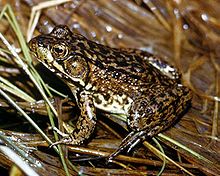- Mink Frog
-
Mink Frog 
Conservation status Scientific classification Kingdom: Animalia Phylum: Chordata Class: Amphibia Order: Anura Family: Ranidae Genus: Rana Species: R. septentrionalis Binomial name Rana septentrionalis
Baird, 1854Synonyms Rana septentrionalis The Mink Frog (Rana septentrionalis) is a small species of frog native to the United States and Canada. They are so named for their scent, which reportedly smells like a mink. The scent is more akin to that of rotting onions to those unfamiliar with mink. It is also sometimes referred to as the North Frog.
Contents
Physical description
The Mink Frog is a small frog, growing up to 4.8 to 7.6 cm (1.9 to 3.0 in). The dorsum is generally green in color, with darker green and brown blotching and the belly is a cream, yellow or white in color. They are sexually dimorphic in that males typically have a bright yellow colored throat, while females have a white colored throat, and the tympanum of the male is larger than the eye, while the female's is smaller than or the same size as the eye.
Ecology and behavior
The Mink Frog is predominantly aquatic, living among the vegetation (especially among lily pads) in ponds, swamps, and streams around wooded areas. They feed on a wide variety of things, including spiders, snails, beetles, and other invertebrates. As tadpoles they consume primarily algae and decaying plant matter.
Reproduction
Mating generally takes place in late spring and early summer. Males call to attract females while floating in the water. Between 500 and 4000 eggs can be laid by the female at any one time, generally in deep water. Tadpoles remain in the larval stage for approximately one year before metamorphosing into froglets. Maturity is reached in a year for males, and two years for females.
Geographic range
Mink frogs are found in the United States in the states of Minnesota, New Hampshire, Wisconsin, Michigan, Maine, Vermont, and New York. They are also found in Canada in the provinces of Nova Scotia, New Brunswick, Quebec, Ontario, and Manitoba.
Conservation Status
In recent years, it seems that the general populations of Mink frogs are in decline.[2] In a 1999 study conducted by David Gardiner and David Hoppe it was noted that there was an increase in Mink frog deformites. "The spectrum of deformities includes missing limbs, truncated limbs, extra limbs (including extra pelvic girdles), and skin webbings. We also describe a newly recognized malformation of the proximal-distal limb axis, a bony triangle. In this abnormality, the proximal and distal ends of the bone are adjacent to one another forming the base of a triangle. The shaft of the bone is bent double and protrudes laterally, the midpoint of the bone forming the apex of the triangle."[3] The study comes to the conclusion that these deformities are a result of exposure to exogenous retinoids, but more study is needed to make a sure determination.
References
- ^ Hammerson (2004). Rana septentrionalis. 2006. IUCN Red List of Threatened Species. IUCN 2006. www.iucnredlist.org. Retrieved on 12 May 2006. Database entry includes a range map and a brief justification of why this species is of least concern.
- ^ Harding, J. 1997. Amphibians and Reptiles of the Great Lakes Region. MI: The University of Michigan Press.
- ^ Gardiner, D. M., & Hoppe, D. M. (1999). Environmentally induced limb malformations in mink frogs (Rana septentrionalis). Journal of Experimental Zoology, 284(2), 207-216.
- Hillis, D.M. & Wilcox, T.P. (2005): Phylogeny of the New World true frogs (Rana). Mol. Phylogenet. Evol. 34(2): 299–314. doi:10.1016/j.ympev.2004.10.007 PDF fulltext.
- Hillis, D. M. (2007) Constraints in naming parts of the Tree of Life. Mol. Phylogenet. Evol. 42: 331–338.
External links
Categories:- IUCN Red List least concern species
- Amphibians of Canada
- Lithobates
- Rana
- Amphibians of the United States
- Fauna of the Northeastern United States
Wikimedia Foundation. 2010.

